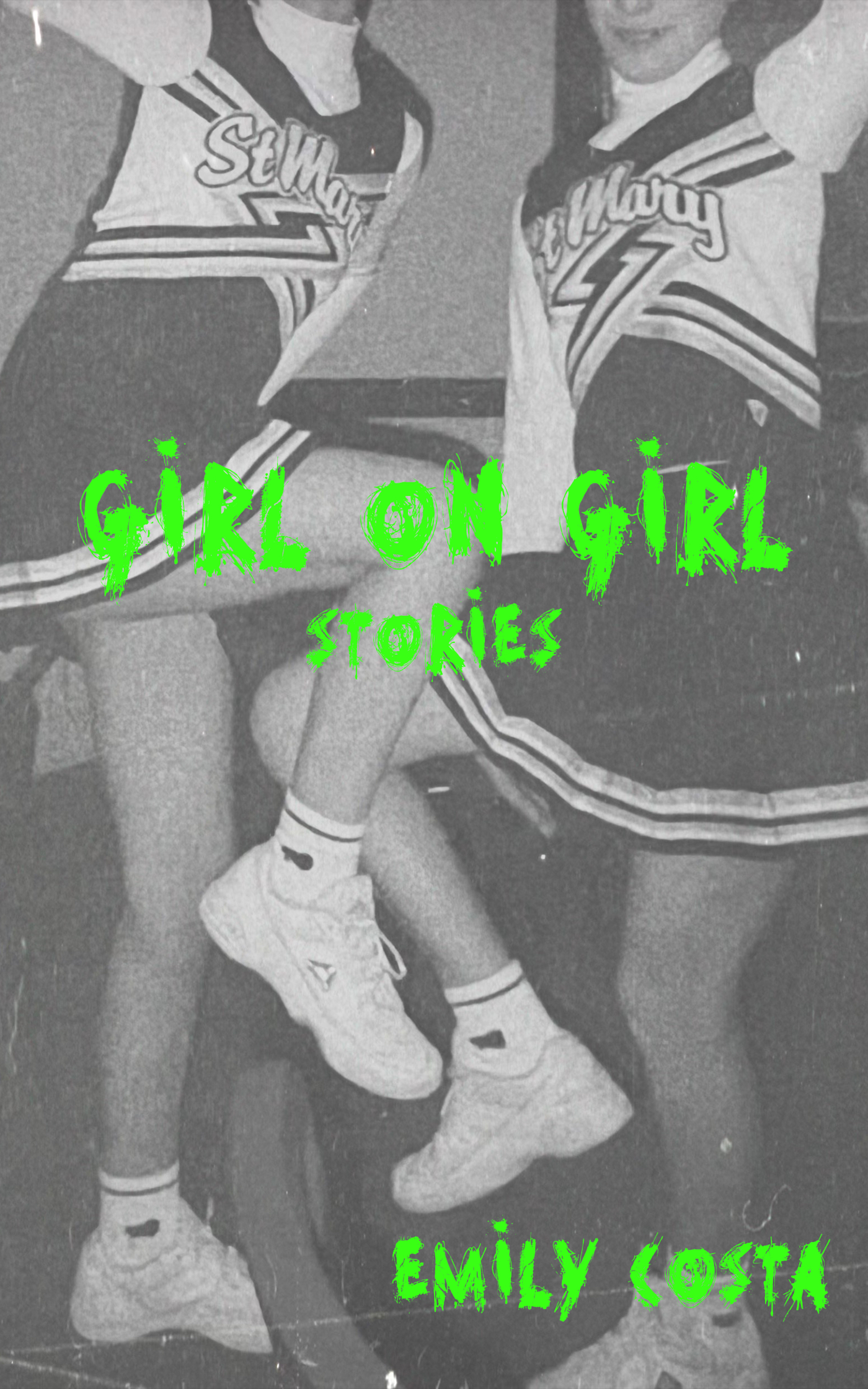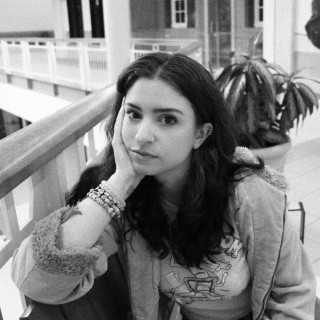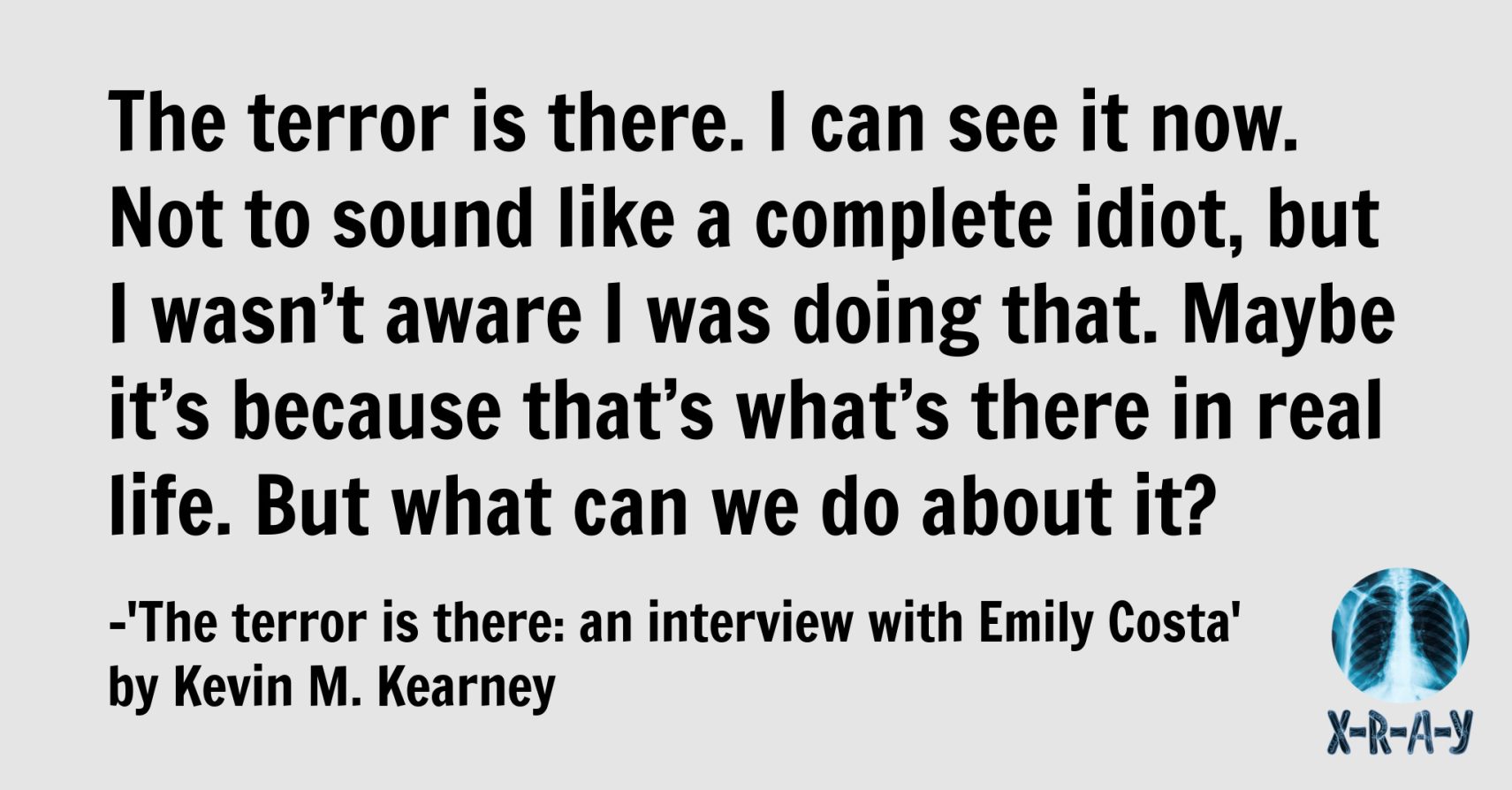
Emily Costa’s debut story collection GIRL ON GIRL (Rejection Letters, 2024) isn’t a book of horror, at least not in the traditional sense. These stories can be horrifying, sure, and there’s a palpable uneasiness in nearly every chapter, but Costa’s premises are notably banal: girls at an ice cream shop deal with their shitty boss, two moms take their children on a playdate, high schoolers drink warm High Life in a half-empty basement. That’s not to say they’re boring. Costa’s fiction interrogates how those seemingly innocuous interactions are so often charged with aggression and violence—how quickly a welcoming smile can turn into a menacing smirk.
Like Bennett Sims’ Other Minds and Juliet Escoria’s You Are the Snake, two other collections from this year, Costa’s GIRL ON GIRL is subtly terrifying, exposing the unsettling realities lurking beneath our common experiences. I’m not surprised at how great the book is—I’d been a fan of her fiction for years, and loved UNTIL IT FEELS RIGHT (Autofocus, 2022), her memoir of undergoing cognitive behavioral therapy for obsessive-compulsive disorder—but I was still amazed at how seamlessly she pulled it off.
I called Costa on GIRL ON GIRL’s official release date to ask her about developing as a writer, assembling a story collection, and figuring yourself out through fiction. The conversation has been lightly edited for clarity.
Kevin M. Kearney: We’re talking on the official release day for GIRL ON GIRL. I know you’re sick, but are you doing anything to celebrate?
Emily Costa: I’m…not. I am not teaching today—I had my last class yesterday. I’m all caught up on grading and that is a reward in itself. I’m going to watch a movie tonight and my husband did get a cake, which was really sweet. That’s the extent of it, though.
KK: That’s awesome. Does the cake say anything about the book release or is it just a cake?
EC: It’s just a cake. It’s from a really nice Italian bakery, so I’m excited about that. It says, like, “Congrats!” or whatever on it.
KK: I would imagine if he asked for the book title at a bakery that might lead to problems.
EC: [Laughs.] Yeah, not a good idea.
KK: Were your students aware of your book?

EC: I don’t think so. I finally just switched to the English Department after 10 years and I’m teaching Comp. We’re talking about arguments and all that. But a student just told me that she dropped out of Engineering major to become a Creative Writing major because she really enjoyed the class. So, that was really great to hear. But I don’t think they know about the book, although I am planning a reading. I teach at the school where I got my MFA, so my mentor, my MFA advisor, is planning a reading for the spring. So, they can figure it out. I guess I’ve got to be careful about what I read.
KK: A lot of these stories don’t take place in college, but they do take place in high school, or they’re centered on people thinking back on high
school. Were you writing much fiction when you were a high schooler?
EC: I started writing then. It was really bad. I was attempting to write books about dogs when I was, I don’t know, 8 to 12. I don’t know why. Finally, in high school I thought, “Wait, that’s not just some stupid thing I was doing? I could actually get good at this? Or try? Or take a class?” I was writing. It was really embarrassing. I still have some of that stuff, and…I won’t be revisiting it anytime soon.
KK: Was it a very early version of what you’ve now developed? Or was it just Dog Fiction?
EC: [Laughs.] I quit the Dog Fiction! That stuff was more…I remember when everything clicked for me Junior year. I had a really good English teacher. I think this happens to everybody. We got to this one portfolio where we got to do all these different writing assignments, showing different parts of ourselves. I guess it was essentially CNF. It was just fun to write in that way. Freshman year, me and my friends were trying to put together a little magazine and it didn’t go anywhere. None of it was really serious, but it was cool to see there were opportunities to do this. And people were encouraging, so that was really nice.
KK: When did you start taking writing more seriously?
EC: I was an English major, but I didn’t take any Creative Writing classes until I went to grad school. I was just writing here and there. It was fun, but I didn’t ever really know what to do with it. In college, there was a class where we read short stories and wrote essays about them. But one of the assignments was we could write a short story based on one we’d read. I wrote one based on “A&P” by John Updike. It was a lightly fictionalized version of an awful job I had. This is a recurring theme for me. I worked at an amusement park as a 16 year old. It was just bad.
But my teacher was really nice to me about it. So that was always in the back of my head: “It’d be really fun to do something with this. I enjoyed this a lot. I don’t love writing essays about Henry James.” So then I eventually decided to pursue the MFA.
KK: I’ve never assembled a story collection, so I’m always interested in the process behind putting one together. It seems like everyone has their own philosophy. What was yours?
EC: I really just went by vibes, but I wanted to vary the length and the points of view. But there’s so many of the same themes that I didn’t know where to put the one where the cat goes into space. [Laughs.] In conclusion, I didn’t put in a ton of thought and I really just went by feel of whether it felt right together.
KK: Reading it felt more like a novel. I struggle with reading through a story collection because I feel like I need to stop at the end of each chapter knowing the next will be wildly different. There are a lot of distinctions between your stories, but it felt like you were always driving at something larger. One of those things is the past—the woman in “Ethan Marino” can’t move beyond the social hierarchies of high school, the mom in “Dead Mall” is fascinated with old toys, the girl in “Balefire” is still processing a traumatic episode from years earlier. What draws you to characters like these, who are so focused on the past?
EC: I think that’s me trying to figure out what’s wrong with me. [Laughs.] I don’t know. It’s really just me trying to figure out why I’m so drawn to the past and can’t move forward in a lot of ways in my life. I don’t think I ever figure it out and I think most of these characters end up in trouble because of their focus on the past. There’s a lot of feeling stuck and not knowing how to move forward, and getting it wrong, over and over.
What’s been interesting in talking about these stories is I have to be aware of what I did, and a lot of it I didn’t do on purpose. I didn’t know I was writing all of these stories about these people who are really stuck in the past until D.T. [Robbins, publisher of Rejection Letters] was, like, “Write a synopsis.” [Laughs.] Then I realized it and thought, “Shit—what do I do now?” Maybe, by getting it all out on the page, I can move forward. Like I’m lifting some curse. I really don’t know.
KK: Like you said, I’m rarely aiming for something in my fiction. I don’t know that I’ve ever had a moral or a theme I’m trying to develop over the course of a story. It’s just a story and I try to make it as interesting as possible or as fun as possible. And then I go back to read it and I can see all these kernels that it feels like my subconscious has planted along the way.
EC: Yes. Yes.
KK: It’s my brain screaming at me, “You need to deal with this thing.”
EC: That’s exactly it.
KK: I revisited your memoir about outpatient therapy for OCD, UNTIL IT FEELS RIGHT, in advance of reading the collection. At one point, you write, “I know this whole thing, this whole disorder, is about trying to control the uncontrollable, scrambling around in the unknown for footing.” I underlined that immediately and wrote in the margin: WRITING. [Laughs.]
EC: I think now it’s starting to feel clearer that it was my subconscious doing it. I don’t know what was going on before. But now I’m looking at the stories I put in and what’s going on in them.
I was talking with my friend about CNF versus fiction; about what freedoms you have in fiction versus where you’re stuck in CNF, trying to use what you have in real life and put clues together to figure yourself out. I think I’ve been trying…it’s so navel-gazy and self-absorbed, but I’ve been trying to figure myself out in the fiction, too. I didn’t think I was. But I was drawn to certain things and I was drawn to them because I couldn’t figure them out in my life.
What’s been fun in writing fiction is you can do whatever you want. You can choose something you wouldn’t have done in your real life and see what the consequences of that are. You can take it as far as it can go.
It sounds so obvious, so many people have come to this conclusion before, but I was really keeping those worlds separate. I have a friend who didn’t know I wrote fiction because they only knew the other stuff, the CNF, but to me I guess they all now just seem intertwined. The stuff I’m working on now is this autofiction stuff—or whatever the hell you want to call it—and I’m calling it that because I was writing it as memoir and felt so stuck, so bogged down and bummed about the past. It felt so sad to me, like trauma porn, and not anything I wanted. I talked to another person about it and they were like, “Just make it fiction.” Oh, duh, okay, obvious. Ever since then, it’s been fun. That was the key that unlocked everything. I’m seeing that they’re not as separate as I was keeping them in my brain.
KK: Is this the novel about your dad’s video rental store?
EC: Yeah, it is.
KK: Is it stylistically similar to your short fiction? Is it at all like your memoir? Is it completely different from both of those?
EC: I think it’s similar to the short fiction, but…and this might change, because I don’t know how much mileage I can get out of it…but I’m doing it from a child’s perspective. First person. Starts with me—or the character of Emily, or whatever—at six years old all the way through high school. We’ll see how long I can sustain that. Or if anybody would ever want to read that. [Laughs.]
It’s been fun because you’re limited by the age. “Would this character use these words?” That kind of stuff. That part of it is fun. I have a child who’s seven-and-a-half, so I’ve been studying him. If he would say it, then it’s fine. I’ve also been using my own home movies and my grief journals from when I was five to see what I said or what I was interested in. [Laughs.] This is where I’m showing you how clearly stuck in the past I am. Really, really deep into what was going on in 1993.
KK: There’s a slight terror simmering in the background of a lot of the stories in GIRL ON GIRL. If the settings were different, someone would maybe call it “gothic.” I know “horror” has been used to describe it. Or maybe genre’s made up and it doesn’t really matter. Is that terror something you were actively aiming for or is that something that naturally seeps into your fiction?
EC: I guess it’s just something that naturally occurs. The terror is there. I can see it now. Not to sound like a complete idiot, but I wasn’t aware I was doing that. Maybe it’s because that’s what’s there in real life. But what can we do about it? How can we interact with it? How can we pull it to the forefront?

